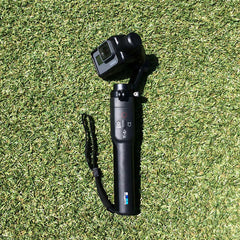GoPro Karma Grip Review
Written by Craig Rhodes-Harrison
Towards the end of 2016, GoPro unveiled their new HERO5 camera platform. The show didn’t stop there though as GoPro went one step further by announcing the introduction of KARMA Grip, their first attempt at unlocking the ever-growing, hand-held gimbal market.
It’s great to see GoPro fill the existing vacancy in their offering as effectively KARMA Grip is the answer to many GoPro user’s prayers who up until now, have had to rely on third party gimbals to satisfy their stabilization wants and needs. That said, there are several top quality, third party gimbals in the market, that are specifically designed around GoPro cameras. Will KARMA Grip hold its own or will it be outgunned? Read on for more.



The Basics:
KARMA Grip arrives in a neat and durable, black case along with the relevant charging and mounting accessories to get you started. There are two parts to the actual gimbal, the camera harness and the handle part of the grip.
The standard camera harness is designed around the HERO5 Black, however KARMA Grip is also compatible with the HERO5 Session and HERO4 Black via interchangeable camera harnesses, each of which are sold separately.
The harness itself follows a simple but robust design and its relatively easy to plug in the camera, although you do have to remove the side door of the HERO5 Black for KARMA Grip to access the brain of the camera via the USB-C and Micro-HDMI ports.
The cylindrical, handle part of the grip consists of the built-in, rechargeable battery, USB-C charging port and control panel. KARMA Grip follows a simple four button approach namely:
- Start and stop video
- Power on/off and changing mode
- Highlight tagging
- Tilt-locking and battery status
The first three buttons are self-explanatory and all relate directly to the camera whereas the final button relates only to the KARMA Grip. The tilt-lock feature is not ground-breaking, however it is something that all decent gimbals tend to have as it’s great for locking the camera at a set angle, following a specific subject as well as those above or below the horizon shots. So far so good, however an adjustable tilt or pan setting/control would be a neat addition.
When it comes to mounting KARMA Grip, the gimbal arrives with a metal mounting ring that fits around the neck of the device. That ring is compatible with most GoPro mounts so the options are diverse, however users should think carefully before mounting due to the size and weight of KARMA Grip. The good news here is that GoPro will be launching an extension cable soon which should solve all mounting concerns.
Design & Build Quality:
KARMA Grip is made from a combination of hard plastic and durable rubber, similar to what can be found on the HERO5 Black. The first thing that comes to mind when picking up KARMA Grip is that this ‘thing’ is hardcore. This gimbal was meant to be used and ultimately put to test in the toughest environments where users wouldn’t dare venture with other gimbals.
In terms of size and weight, KARMA Grip is on the heavier and bulkier side, however in terms of actual dimensions (length, width and diameter) it is much of a muchness. Again, the build quality speaks to the avenue that GoPro was pursuing when launching this into the saturated gimbal market, that of the USP of strength and durability.

Performance:
At the end of the day, gimbals can have all the technical features in the world or be class-leading from a build and size perspective however where the cookie really crumbles is around the stabilization and its performance thereof.
In this department, GoPro’s KARMA Grip knocks it out the park. KARMA Grip is hands down the strongest gimbal I have personally handled and despite my best efforts, I couldn’t get the motors to drop or fail which was relatively easy on other gimbals. This translates into ultra-smooth footage and a device that you can rely on consistently to deliver the goods in almost any conditions bar underwater.
When it comes to battery life, KARMA Grip offers between 90 – 120 minutes, which is not bad considering the battery must power multiple motors as well as charge the camera when in use. One thing to note though is that KARMA Grip takes incredibly long to charge (up to six hours) and with no replaceable battery, users need to manage the battery quite carefully when on full day adventures
Wrap Up:
If you’re looking for a hand-held gimbal that has multitude of controls for adjusting angles, tilt and pan settings then KARMA Grip will leave you wondering. However, if you’re an outdoor, adventure enthusiast like me then the strong, simple and powerful nature of the KARMA Grip will leave you shocked at just how capable this gimbal is as well as how incredibly smooth the footage is.
There’s definitely room for improvement on the KARMA Grip (size, mount ability and control options) however in terms of the fundamental, stabilization job to be done here, KARMA Grip is right up there with the very best, but goes one step further by being the most rugged and durable option on the market.
If you’re interested in more GoPro content then swing by Craig's personal Instagram account (@craigrh_).

